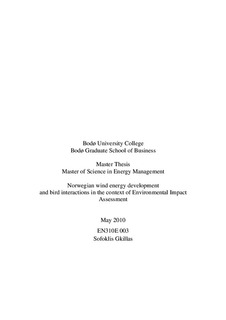Norwegian wind energy development and bird interactions in the context of environmental impact assessment
Master thesis
Permanent lenke
http://hdl.handle.net/11250/140901Utgivelsesdato
2010Metadata
Vis full innførselSamlinger
Sammendrag
This is the prelude of the present Master Thesis focused on the Environmental
Impact Assessments in the Norwegian wind energy sector. Norway, which has
established a target to increase its renewable energy production and energy efficiency
to 30 TWh per year in 2016 (compared to 2001), has made a significant turn to wind
power development as an efficient alternative energy resource. Nevertheless, green
political goals in the past and nature conservation issues, like excessive fatal bird
collisions with wind turbines, create cautiousness concerning this wind power
venture. Thus, the purpose of this academic research is to discover how Norwegian
government is managing to wear thin the negative impacts of wind farms on bird
populations; based on a case study on Smøla wind farm, having the largest installed
wind power capacity in Norway. These environmental challenges are emphasized and
discussed, especially in the context of the Environmental Impact Assessments being
carried out. Procedures, guidelines and directives for wind farm licensing and
environmental impact assessments are used, discussed, being compared to EU‟s ones
and analyzed at length, in order to examine how sustainability in the Norwegian wind
power industry can be achieved in an efficient way. In researcher‟s efforts, he
attempts to clarify to what extent improvements for mitigating negative bird and wind
farm interactions are feasible practically.
Beskrivelse
Masteroppgave i Energy management - Høgskolen i Bodø, 2010
